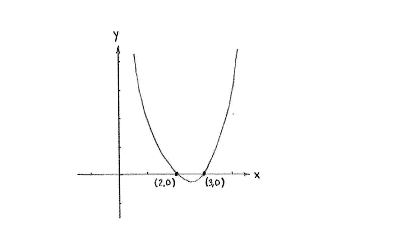Solution 2.3:9b
From Förberedande kurs i matematik 1
m (Lösning 2.3:9b moved to Solution 2.3:9b: Robot: moved page) |
|||
| Line 1: | Line 1: | ||
| - | {{ | + | The points of intersection are those points on the curve which also lie on the |
| - | < | + | <math>~x</math> |
| - | {{ | + | -axis, i.e. they are those points which satisfy both the equation of the curve |
| + | <math>y=x^{\text{2}}-\text{5}x+\text{6}</math> | ||
| + | and the equation of the | ||
| + | <math>~x</math> | ||
| + | -axis | ||
| + | <math>y=0</math>, | ||
| + | |||
| + | |||
| + | <math>\left\{ \begin{matrix} | ||
| + | y=x^{\text{2}}-\text{5}x+\text{6} \\ | ||
| + | y=0\quad \quad \quad \quad \\ | ||
| + | \end{matrix} \right.</math> | ||
| + | |||
| + | |||
| + | This system of equations gives directly that | ||
| + | <math>y=0</math> | ||
| + | and that | ||
| + | <math>~x</math> | ||
| + | must satisfy the second-order equation | ||
| + | <math>x^{\text{2}}-\text{5}x+\text{6}=0</math> | ||
| + | . By completing the square, we obtain that the left-hand side is | ||
| + | |||
| + | |||
| + | <math>\begin{align} | ||
| + | & x^{\text{2}}-\text{5}x+\text{6}=\left( x-\frac{5}{2} \right)^{2}-\left( \frac{5}{2} \right)^{2}+6 \\ | ||
| + | & =\left( x-\frac{5}{2} \right)^{2}-\frac{25}{4}+\frac{24}{4}=\left( x-\frac{5}{2} \right)^{2}-\frac{1}{4} \\ | ||
| + | \end{align}</math> | ||
| + | |||
| + | |||
| + | and this gives that the equation has solutions | ||
| + | |||
| + | <math>x=\frac{5}{2}\pm \frac{1}{2}</math>, i.e. | ||
| + | <math>x=\frac{5}{2}-\frac{1}{2}=\frac{4}{2}=2</math> | ||
| + | and | ||
| + | <math>x=\frac{5}{2}+\frac{1}{2}=\frac{6}{2}=3</math>. | ||
| + | |||
| + | The intersection points are therefore | ||
| + | <math>\left( 2 \right.,\left. 0 \right)</math> | ||
| + | and | ||
| + | <math>\left( 3 \right.,\left. 0 \right)</math>. | ||
| + | |||
| + | |||
| + | |||
{{NAVCONTENT_START}} | {{NAVCONTENT_START}} | ||
<center> [[Image:2_3_9b-2(2).gif]] </center> | <center> [[Image:2_3_9b-2(2).gif]] </center> | ||
{{NAVCONTENT_STOP}} | {{NAVCONTENT_STOP}} | ||
Revision as of 11:57, 21 September 2008
The points of intersection are those points on the curve which also lie on the \displaystyle ~x -axis, i.e. they are those points which satisfy both the equation of the curve \displaystyle y=x^{\text{2}}-\text{5}x+\text{6} and the equation of the \displaystyle ~x -axis \displaystyle y=0,
\displaystyle \left\{ \begin{matrix}
y=x^{\text{2}}-\text{5}x+\text{6} \\
y=0\quad \quad \quad \quad \\
\end{matrix} \right.
This system of equations gives directly that
\displaystyle y=0
and that
\displaystyle ~x
must satisfy the second-order equation
\displaystyle x^{\text{2}}-\text{5}x+\text{6}=0
. By completing the square, we obtain that the left-hand side is
\displaystyle \begin{align}
& x^{\text{2}}-\text{5}x+\text{6}=\left( x-\frac{5}{2} \right)^{2}-\left( \frac{5}{2} \right)^{2}+6 \\
& =\left( x-\frac{5}{2} \right)^{2}-\frac{25}{4}+\frac{24}{4}=\left( x-\frac{5}{2} \right)^{2}-\frac{1}{4} \\
\end{align}
and this gives that the equation has solutions
\displaystyle x=\frac{5}{2}\pm \frac{1}{2}, i.e. \displaystyle x=\frac{5}{2}-\frac{1}{2}=\frac{4}{2}=2 and \displaystyle x=\frac{5}{2}+\frac{1}{2}=\frac{6}{2}=3.
The intersection points are therefore \displaystyle \left( 2 \right.,\left. 0 \right) and \displaystyle \left( 3 \right.,\left. 0 \right).

